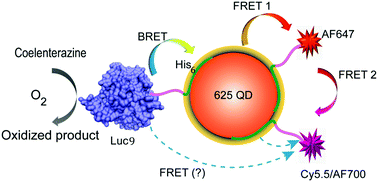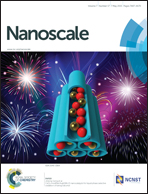An enzymatically-sensitized sequential and concentric energy transfer relay self-assembled around semiconductor quantum dots†
Abstract
The ability to control light energy within de novo nanoscale structures and devices will greatly benefit their continuing development and ultimate application. Ideally, this control should extend from generating the light itself to its spatial propagation within the device along with providing defined emission wavelength(s), all in a stand-alone modality. Here we design and characterize macromolecular nanoassemblies consisting of semiconductor quantum dots (QDs), several differentially dye-labeled peptides and the enzyme luciferase which cumulatively demonstrate many of these capabilities by engaging in multiple-sequential energy transfer steps. To create these structures, recombinantly-expressed luciferase and the dye-labeled peptides were appended with a terminal polyhistidine sequence allowing for controlled ratiometric self-assembly around the QDs via metal-affinity coordination. The QDs serve to provide multiple roles in these structures including as central assembly platforms or nanoscaffolds along with acting as a potent energy harvesting and transfer relay. The devices are activated by addition of coelenterazine H substrate which is oxidized by luciferase producing light energy which sensitizes the central 625 nm emitting QD acceptor by bioluminescence resonance energy transfer (BRET). The sensitized QD, in turn, acts as a relay and transfers the energy to a first peptide-labeled Alexa Fluor 647 acceptor dye displayed on its surface. This dye then transfers energy to a second red-shifted peptide-labeled dye acceptor on the QD surface through a second concentric Förster resonance energy transfer (FRET) process. Alexa Fluor 700 and Cy5.5 are both tested in the role of this terminal FRET acceptor. Photophysical analysis of spectral profiles from the resulting sequential BRET–FRET–FRET processes allow us to estimate the efficiency of each of the transfer steps. Importantly, the efficiency of each step within this energy transfer cascade can be controlled to some extent by the number of enzymes/peptides displayed on the QD. Further optimization of the energy transfer process(es) along with potential applications of such devices are finally discussed.


 Please wait while we load your content...
Please wait while we load your content...